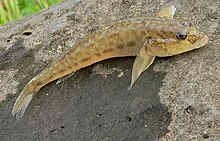Monkey goby
| Monkey goby | |
|---|---|

| |
| Scientific classification | |
| Domain: | Eukaryota |
| Kingdom: | Animalia |
| Phylum: | Chordata |
| Class: | Actinopterygii |
| Order: | Gobiiformes |
| Family: | Gobiidae |
| Genus: | Neogobius |
| Species: | N. fluviatilis
|
| Binomial name | |
| Neogobius fluviatilis (Pallas, 1814)
| |

| |
| The range of the Monkey goby | |
| Synonyms | |
| |
The monkey goby (Neogobius fluviatilis) is a species of goby native to the basins of the Black Sea and the Sea of Azov.
Characteristics
The monkey goby is covered with
caudal fins
. The average adult monkey goby measures 7–10 centimeters, but has been known to grow to lengths of 18–20 centimeters. This species weighs around 50 grams.
Range
The natural
fresh and brackish waters of basins in the Black Sea and the Sea of Marmara.[2] In the basin of the Sea of Marmara, it is a common sight in Manyas, Sapanca, and the Kazoli River in Bosporus
Strait.
In the Black Sea and the surrounding areas, the monkey goby is common in all desalinated water including the .
Recently, the monkey goby has been registered as an non-indigenous in Lake Balaton in Hungary.[3] The monkey goby was discovered in the Middle Danube in Hungary in 1984.[4] In 2001 it was found to have spread to the Slovak-Hungarian sector of the Danube River.[5] In the basin of the Baltic Sea it was first registered as an invasive species in 1997.[6] The species has also become a common sight in the Włocławek Reservoir and Zegrze Reservoir.[7]
The monkey goby has been found in the
In August 2011 the monkey goby is registered for the first time in the
Feeding
The monkey goby belongs to the group known as
Kugurluy, the diet of the monkey goby consists of amphipods, molluscs, and Oligochaeta.[13]
In the
sea weed such as Zostera marina, and amphipods such as Marinogammarus olivii. Certain planktonic crustaceans
are also present in the diet of adult gobies.
Parasites

In the northwestern
ducklings.[18]
Importance
In
Dnieper-Bug Estuary
. It plays an important role in the food chain by serving as prey for other predatory fish living in these areas.
References
- . Retrieved 16 November 2021.
- flatfishes, : Naukova Dumka, 320 pp. (in Russian)
- ^ Bíro P. (1971) Neogobius fluviutilis in Lake Balaton - a Ponto-Caspian goby new to the fauna of central Europe. J. Fish Biol., 4: 249-255.[1]
- ^ Pintér K. (1989) Fishes of Hungary. Akadémiai Kiadó, Budapest, 202 pp.
- ^ Stráňai I., Andeji J. (2001) Monkey goby – (so far) the last invasing species from the gobiids family. Polovnictvo a rybárstvo (Bratislava), 53: 44-45.
- ^ Danilkiewicz Z. (1998) Babka szczupła, Neogobius fluviatilis (Pallas, 1811), Perciformes, Gobiidae – nowy, pontyjski element w ichtiofaunie zlewiska Morza Bałtyckiego. Fragm. Faun., 41(21): 269–277.
- ^ Kostrzewa J., Grabowski M. (2002) Babka szczupła, Neogobius fluviatilis (Pallas, 1814), w Wiśle - fenomen inwazji pontokaspijskich Gobiidae. Przegl. Zool., 46(3-4): 235-242.
- ^ van Kessel N., Dorenbosch M., Spikmans F. (2009) First record of Pontian monkey goby, Neogobius fluviatilis (Pallas, 1814), in the Dutch Rhine. Aquatic Invasions, 4(2): 421-424.[2]
- ^ Zogaris S., Apostolou A. (2011) First record of Pontian Monkey Goby, Neogobius fluviatilis (Pallas, 1814) in the Evros River (Greece); is it an alien species? Archived 2012-04-26 at the Wayback Machine Mediterranean Marine Science, 12(2): 454-461.
- ^ Andriyashev A.R., Arnoldi L.V. (1945) O biologiipitaniya nekotoryh donnyh ryb Chernogo morya. Zhurn. obshch. biol., 6(1): 53-61. (in Russian)
- ^ Lus V.Ya. (1963) Pitaniye bychkov (sem. Gobiidae) Azovskogo morya. Trudy Instituta okeanologii, 62: 96-127. (in Russian)
- ^ Borisenko A.M. (1946) Kolichestvennyj uchet donnoy fauny Tendrovskogo zaliva: Abstract of PhD Thesis, Karadag, 18 p. (in Russian)
- ^ Grinbart S.B. (1964) Zhivlennia bentosoyidnyh ryb i kormovi resursy zoobentosu lymaniv (Yalpuh, Kugurluy) [In:] Tezy dop. I resp. konf. VGBT, 9, Kiev, Naukova Dumka, pp. 68-69. (in Ukrainian)
- ^ Kudrenko S., Kvach Y. (2005) Diet composition of two gobiid species in the Khadzhibey Estuary (North-Western Black Sea, Ukraine). Acta Universitatis Nicolai Copernici, Limnological Papers, 24: 61-68.
- ^ Kvach Y. (2005) A comparative analysis of helminth faunas and infection of ten species of gobiid fishes (Actinopterigii: Gobiidae) from the North-Western Black Sea. Acta Ichthyologica et Piscatoria, 35(2): 103–110.[3]
- ^ Youssef M.M., Mansour N.S., Awadalla H.N., Hammouda N.A., Khalifa R., Boulos L.M. (1987) Heterophyid parasite of man from Idku, Maryat and Manzala Lakes areas in Egypt. J. Egypt. Soc. Parasitol., 17: 474–479.
- ^ Zimmerman M.R., Smith G.S. (1975) A probable case of occidental inhumation of 1600 years ago. Bull. N.Y. Acad. Med., 51(7): 828–837.
- ^ Kovalenko I.I. (1960) Izucenie cikla razvitiâ nekotoryh gel’mintov domasnih utok v hozâjstvah na Azovskom poberez’e. Doklady AN SSSR, 133(5): 1259–1261.(In Russian)
Further reading
- Fishes of waters of Ukraine / Monkey goby (Neogobius fluviatilis (Pallas, 1814)) - in Russian
- Digitaler Fischertenatles von Deutschland und Österreich / Neogobius fluviatilis Pallas, 1814 - Flussgrundel - in German

